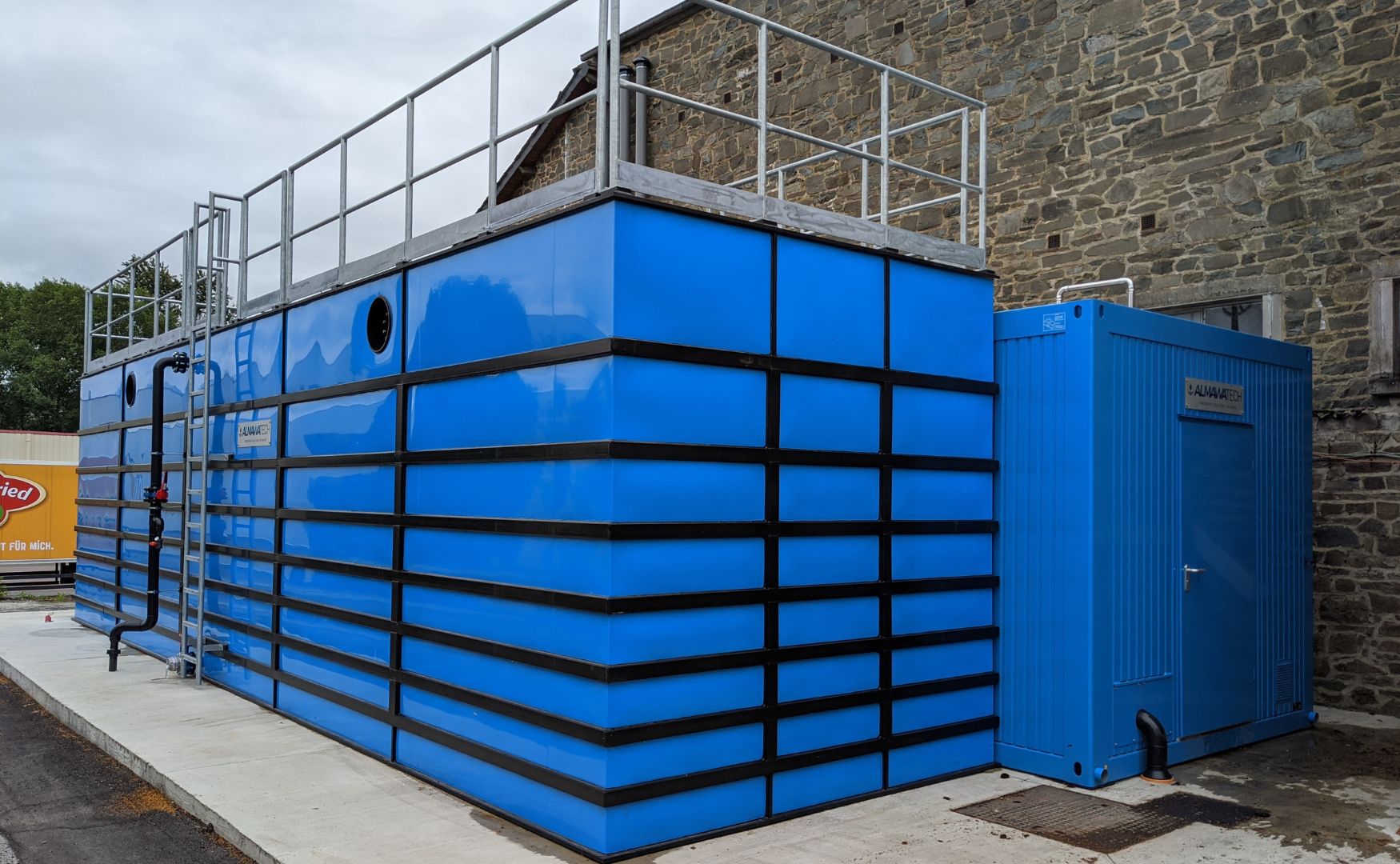A moving bed biofilm reactor (MBBR) is a modern technology for biological water and wastewater treatment based on the use of biofilms. Specially developed carrier materials are used in the reactor, on which microorganisms colonize and form biofilms. These biofilms are responsible for the degradation of organic and inorganic substances.
The suspended bed reactor is characterized by high efficiency, compact design and flexibility and is used in both municipal and industrial water and wastewater treatment.
Table of contents
Structure of a floating bed reactor
A floating bed reactor consists of the following main components:
reactor vessel:
- Made of concrete or steel, often cylindrical or rectangular.
- Size and shape depend on the intended application and load.
Carrier material:
- Specially shaped plastic carriers with a large specific surface area (500-1500 m²/m³), which serve as a colonization surface for microorganisms.
- Material: Polyethylene (PE) or polypropylene (PP).
- Properties:
- Buoyant due to lower density than water.
- High chemical and mechanical resistance.
Ventilation system:
- Fine-bubble diffusers or aerators supply oxygen, which is required for aerobic decomposition, and keep the carriers moving.
Restraint system:
- Screen designs or special retention devices ensure that the carriers remain in the reactor while the purified water exits the system.
Control and monitoring:
- Sensors measure important parameters such as oxygen content, pH value, ammonium, nitrate and temperature in order to optimize operation.
Functionality
The suspended bed reactor works on the principle of biofilm formation and the degradation of pollutants by microorganisms:
Biofilm formation:
- Microorganisms settle on the surface of the carrier material and form biofilms. These consist of a mixture of aerobic and facultative anaerobic bacteria as well as fungi and protozoa.
Mixing:
- The carrier material is kept in constant motion by the aeration or a flow pump, which ensures an even distribution of the microorganisms and the waste water.
Degradation processes:
- Aerobic degradation:
- Organic substances (BOD/COD) are oxidized to carbon dioxide and water by microorganisms using oxygen.
- Nitrification:
- ammonium (NH4+) is converted by nitrifying bacteria to nitrite (NO2-) and then to nitrate (NO3-) is converted.
- Denitrification:
- Under anoxic conditions, nitrate is converted by heterotrophic microorganisms into nitrogen gas (N2) by heterotrophic microorganisms.
- Aerobic degradation:
Self-cleaning of the biofilm:
- Excess biofilm components are sheared off by the constant movement of the carriers and discharged with the wastewater, allowing the system to regulate itself.

Photo: Our MBBR plant ALMA BIO MBBR in container design
Technical background
carrier materials:
- The design of the carriers influences the efficiency of the system:
- High specific surface area for biofilm growth.
- Optimum pore size to avoid clogging.
- Example: K1 body type or MBBR beam with lamellar structure.
- The design of the carriers influences the efficiency of the system:
Hydraulics:
- The floating bed reactor works with a continuous flow, which ensures a uniform load.
- Typical hydraulic dwell time: 2-6 hours, depending on load and target parameters.
Ventilation:
- Oxygen input is crucial for aerobic degradation. Fine bubble aeration ensures a high oxygen transfer coefficient and reduces energy consumption.
Sludge load:
- Compared to activated sludge processes, the moving bed reactor works with a higher specific biomass concentration, as the biofilm is highly concentrated on the carriers.
Areas of application
1. municipal wastewater treatment
- Supplementing or replacing activated sludge processes in wastewater treatment plants.
- Ideal for systems with space restrictions or capacity expansion.
- Combination with downstream sand filters or membrane systems for further water purification.
2. industrial wastewater treatment
- Food industry:
- Treatment of organically contaminated wastewater, e.g. from dairies or breweries.
- Chemical industry:
- Removal of toxic substances and degradation of poorly degradable organic compounds.
- Petrochemistry:
- Treatment of oily and nitrogen-rich wastewater.
3. water recycling
- Use in closed water circuits for the reuse of process water.
- Combination with reverse osmosis for the production of ultrapure water.
Advantages of the floating bed reactor
High efficiency:
- The high specific biomass concentration means that even heavily contaminated wastewater can be treated effectively.
Compact design:
- Compared to activated sludge processes, the moving bed reactor requires less space as no separate secondary clarifiers are required.
Self-regulation:
- Automatic adjustment of the biomass concentration through self-cleaning of the biofilm.
Flexibility:
- Easy integration into existing systems or modification to expand capacity.
Low sensitivity:
- Stable against hydraulic and organic load fluctuations.
Low maintenance:
- No moving parts inside the reactor, which minimizes maintenance.
Challenges and optimization
Biofilm formation:
- The initialization of the biofilm can take several weeks, but requires careful control of the operating parameters.
Carrier losses:
- Mechanical wear or inadequate restraint systems can lead to the loss of backing material.
Energy consumption:
- Aeration can account for a significant proportion of energy consumption. Optimizing oxygen transfer efficiency is crucial.
Nutrient limitation:
- In wastewater with a low concentration of nitrogen or phosphorus, nutrients must be added to promote biofilm growth.
Conclusion
The floating bed reactor (MBBR) is a highly efficient and flexible technology for biological wastewater treatment. Through the use of carrier materials and the combination of biofilm and flow-through processes, the MBBR achieves a high purification performance in a small space. The floating bed reactor offers an economical and sustainable solution, particularly for industrial wastewater treatment and for expanding the capacity of wastewater treatment plants. Its robustness against load fluctuations and the possibility of modular expansion make it one of the most future-proof technologies in water and wastewater technology.
For further information on our products, please feel free to contact us at any time!







